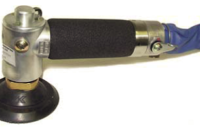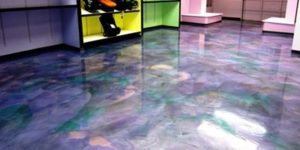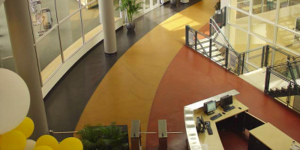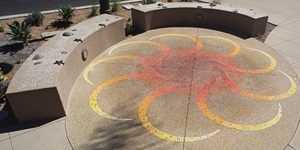So we’re in the early stages of a polishing project after the old VCT (vinyl composition tile) has been removed. We’re progressing with initial grinding diamonds to open the floor, only to have the building owner walk through and complain, “What happened to my floor? What are all those lines? Is my floor ruined? How are you going to fix this floor?”
Those old tile marks and lines in the concrete are called windowpanes, ghosting, or simply tile marks. They usually mirror the former locations of the tiles that were just removed. Once in a while an owner will actually like the interesting patterned appearance of these lines, but the reactions are often anger, confusion and disbelief. As polishers, we need to know what can and cannot be done to fix these problems. The questions: Will I be able to grind through these lines? Are the lines going to get wider or narrower as I grind into the floor? Can I mask the lines by staining the concrete? Will the floor polish up? Is this floor even a viable candidate for polishing?
Why is this happening? Let’s start off by identifying the main causes of tile marks. Ghosting or tile marks are caused and affected by moisture intrusion.
These lines can come from within or below the slab, or they can develop from treatments applied on the VCT above the slab. Since most concrete polishers have not been trained in moisture vapor transmission, concrete mix design, vapor barriers or janitorial maintenance, it will be very useful to learn how these factors affect the overall look and outcome of the polished floor.

Moisture vapor transmission through a concrete slab is caused by the need for the moisture to reach equilibrium, which is achieved when all parts of the system have the same amount of moisture content. When the ground below the slab is very wet and the concrete above it is not, the water will travel from the ground up into the slab because the slab is drier. Then the water will again seek a drier space. Our HVAC systems control the temperature and humidity of the air in the rooms, and as the moisture is removed from conditioned room air, the moisture in the slab will naturally move up through the tile seams toward the dry air. The moisture in question may be from within the slab itself, such as “water of convenience,” the normal amount of water needed to easily place concrete. It can also come from a source underneath the slab, such as a leaky pipe, high water table, or sprinkler system.
Movement of salt-laden water up through the slab is the same phenomenon that causes traditional efflorescence issues with concrete and masonry. Moisture migrates up according to the laws of physics, always seeking equilibrium, while dissolving and carrying along free lime, calcium hydroxide and salts that have not reacted during the curing of the slab. When the salted water evaporates at the slab surface, it leaves the salts behind, which form an ever-widening line. As long as there is a continuous supply of water to the concrete, there will be moisture transmission, and the unsightly, porous tile marks will continue to develop.
Topical treatments or processes are the other major source of tile marks. The quality of the installation itself is a major factor, as is the janitorial treatment of the area. Are all of the tiles tight against one another or is there visible space? Were multiple coats of floor finish applied prior to opening? Did crews prevent janitorial liquids from puddling on the floor for extended time periods? All of these factors help determine the amount of lines and whitening that occurs during years of routine janitorial maintenance procedures.
Washing, waxing, stripping wax and rewaxing processes can drive a steady stream of dirty water directly into the concrete surface. Puddles of chemicals and dirty water (“gray” water) should not be allowed to dwell on the floor. Those seemingly harmless puddles of gray water on top of the VCT seep down through the seams into the concrete slab. Gray water with its residual chemicals soon becomes trapped underneath the tile by subsequent applications of wax and high-speed burnishing. When gray water manages to escape through the tiles’ gaps and seams, it will leave behind the insoluble salts at the surface of the slab: our old nemesis, efflorescence.
As the salts are dissolved from within the slab and moved up to the surface, the body of the concrete loses its free salts and becomes even more porous as a result, allowing yet more gray water to penetrate. This repeated cycle of soaking, dissolving salts, movement of salts to the surface, evaporation of water, and deposition of salty residue at and near the surface helps creates the tile mark problem.
What can you do?
Now that we understand what caused all those lines, let’s get down to answering some other questions: Is the floor ruined? Will these tile marks be there forever? Can the concrete be stained to mask the lines? Will those adhesive stains polish? How come some areas have marks and others don’t? Are the tire marks permanent or will they fade? How are you going to fix this floor?
Your answers should be: “No, maybe, kind of, I don’t know, just because, yes and no, properly polish it.” Whew, that was easy.
Of course, the final answers depend partially on the opinion of the owner, and answers will vary with the actual slab we are polishing. After all, the one thing we know about concrete is that each slab is different, and that is not going to change.
If the marks are from the top down as with marking from gray water, we can often grind off or at least minimize the presence of the tile marks. But if the marks are caused by vapor transmission up through the slab, then no matter how far down we grind, we will just keep finding the same lines, though perhaps wider and even more pronounced.
No, the floor is not ruined, and depending upon the source and severity of the moisture and residue issues, the lines may grind away. Or maybe they won’t. The bottom-line message is that yes, this floor is polishable – it will accept proper densification to rejection and it can be polished up to any degree allowed by the mix design, the equipment, the tools, the chemicals and, of course, the training and skills of the concrete polishing specialist. You can provide the owner with a solid and properly polished concrete floor that can be used with pride for years to come.
Staining the concrete may help give the concrete more of an even tone, but although that may be interpreted as masking or covering up the issue, the truth is that the lines are still going to be visible.
Adhesive stains can be polished, but hardly ever will go away. Adhesive residues, especially from cutback adhesive, will need to be degreased and cleaned until they are water-absorbent. Once a drop of water will penetrate into that discoloration, then we know that densifier will also penetrate. As long as the densifier can penetrate, it will find and react with calcium hydroxide, and then the concrete can be effectively polished and will retain its shine.
Yes, the marks will be permanent, and will not fade over time.
So here’s your final answer: The way you fix the floor is to properly polish it with all of the craftsmanship and expertise that you have learned, using the chemicals and equipment that you trust to produce a floor that will make you and your staff members proud of their work. Make it shine!















